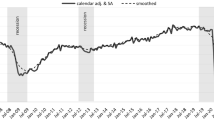Abstract
This paper focuses on temporal aggregation of the cyclical component model as introduced by Harvey (1989). More specifically, it provides the properties of the aggregate process for any generic period of aggregation. As a consequence, the exact link between aggregate and disaggregate parameters can be easily derived. The cyclical model is important due to its relevance in the analysis of business cycle. Given this, two empirical applications are presented in order to compare the estimated parameters of the quarterly models for German and US gross domestic products with those of the corresponding models aggregated to annual frequency.
Similar content being viewed by others
References
Amemiya T, Wu RY (1972) The effect of aggregation on prediction in the autoregressive model. J A Stat Assoc 67: 628–632
Brewer KRW (1973) Some consequences of temporal aggregation and systematic sampling for ARMA and ARMAX models. J Econom 1: 133–154
Canova F (2007) Methods for applied macroeconomic research. Princeton University Press, Princeton
Clark PK (1987) The cyclical component of US economic activity. Q J Econ 102: 797–814
Doornik JA, Hansen H (1994) An Omnibus test for univariate and multivariate normality. Economics working papers W4 & 91, Nuffield College
Harvey AC (1989) Forecasting structural time series and the Kalman filter. Cambridge University Press, Cambridge
Harvey AC, Jaeger A (1993) Detrending, stylised facts and the business cycle. J Appl Econom 8: 231–247
Hassler U (2011) Estimation of fractional integration under temporal aggregation. J Econom 162: 240–247
Hodrick RJ, Prescott EC (1997) Postwar US business cycles: an empirical investigation. J Money Credit Bank 29: 1–16
Hotta LK, Vasconcellos KL (1999) Aggregation and disaggregation of structural time series models. J Time Ser Anal 20: 155–171
Koopman SJ, Harvey AC, Doornik JA, Shephard N (2007) STAMP 8.2 structural time seires analyser, modeller and predictor. Timberlake Consultants Ltd, London
Luati A, Proietti T (2010) Hyper-spherical and elliptical stochastic cycles. J Time Ser Anal 31: 169–181
del Maravall A, Rio A (2007) Temporal aggregation, systematic sampling, and the Hodrick-Prescott filter. Comput Stat Data Anal 52: 975–998
Proietti T (2000) Comparing seasonal components for structural time series models. Int J Forecast 16: 247–260
Sbrana G (2011) Structural time series models and aggregation: some analytical results. J Time Ser Anal 32: 315–316
Silvestrini A, Veredas D (2008) Temporal aggregation of univariate and multivariate time series models: a survey. J Econ Surv 22: 458–497
Stram DO, Wei WWS (1986) Temporal aggregation in the ARIMA process. J Time Ser Anal 7: 279–292
Wei WWS (1978) Some consequences of temporal aggregation in seasonal time series models. In: Zellner A (ed) Seasonal analysis of economic time series. US Department of Commerce, Bureau of the Census, pp 433–444
Weiss A (1984) Systematic sampling and temporal aggregation in time series models. J Econom 26: 271–281
Author information
Authors and Affiliations
Corresponding author
Rights and permissions
About this article
Cite this article
Sbrana, G., Silvestrini, A. Temporal aggregation of cyclical models with business cycle applications. Stat Methods Appl 21, 93–107 (2012). https://doi.org/10.1007/s10260-011-0181-0
Accepted:
Published:
Issue Date:
DOI: https://doi.org/10.1007/s10260-011-0181-0




